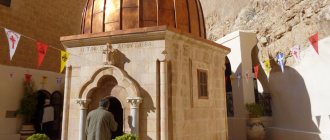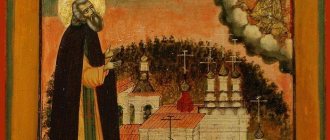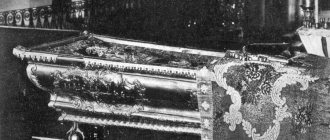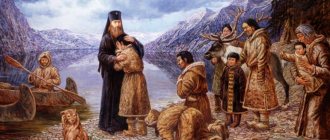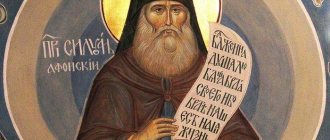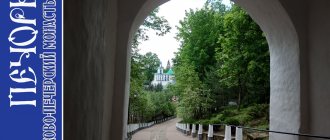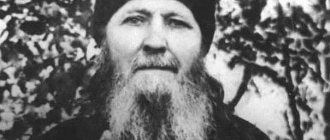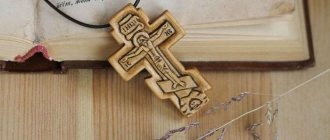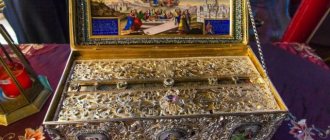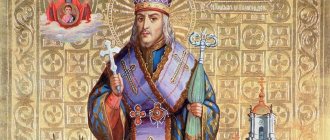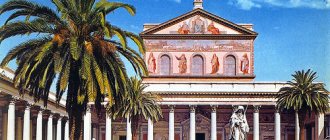| St. Savva the Sanctified |
Savva the Consecrated
(439 - 532), abbot, venerable Memory: December 5 on the day of his death, October 13 on the day of the return of the relics from Italy to the Holy City (ROCOR [1])
Born in 439 in the small town of Mutalaska in Cappadocia into the pious Christian family of John and Sophia. His father was a military leader. Having left for Alexandria on business, he took his wife with him, and left his five-year-old son in the care of his uncle. When the boy was eight years old, he entered the nearby monastery of St. Flavian. The gifted child soon learned to read and studied the Holy Scriptures well. In vain did the parents persuade Saint Sava to return to the world and marry.
At the age of 17, he took monastic vows and was so successful in fasting and prayer that he was awarded the gift of miracles. After spending ten years in the Flavian monastery, the monk went to Jerusalem and entered the monastery of Passarion the Great in Palestine.
Providence soon brought him together with the Monk Euthymius the Great, but he sent Saint Sava to Abba Theoktistus, abbot of the nearby Mucellik monastery with a strict cenobitic charter.
After the death of Elder Theoktistus, his successor blessed the Monk Savva to seclude himself in a cave: only on Saturday did the saint leave the seclusion and come to the monastery, participate in divine services and eat food. After some time, the monk was allowed not to leave the seclusion at all, and Saint Sava labored in the cave for 5 years.
The Monk Euthymius the Great closely followed the life of the young monk and, seeing how he had grown spiritually, began to take him with him to the Ruv desert near the Dead Sea. They left on January 14 and stayed there until the Week of Vai. The Monk Euthymius called Saint Sava a youth-elder and carefully raised him in the highest monastic virtues.
When in 473 the Monk Euthymius the Great departed to the Lord, Saint Sava left the Lavra and settled in a cave near the monastery of the Monk Gerasim of Jordan (+ 475). A few years later, disciples began to gather to the Monk Savva - all those who wanted a monastic life. According to instructions from above (through a pillar of fire), the monks built a church in the cave. This is how the Great Lavra arose in 484. The Lavra was and still serves as one of the centers of Orthodoxy in the East, providing both material assistance and possible education to the surrounding poor Orthodox population.
The Monk Savva founded a total of seven monasteries. Many miracles were revealed through the prayers of the Monk Sava: a spring gushed out in the Lavra, heavy rain fell during a drought, healings of the sick and demon-possessed took place.
At the end of his life, he was sent by Saint Peter of Jerusalem to Emperor Justinian, so that the king would erect a hospital and complete the construction of the New Church in Jerusalem. The emperor agreed and generously presented Saint Sava with funds for the improvement of the Lavra.
Compiled the “Liturgical Rules” (Typik), also known as the Jerusalem Rules.
Died on December 5, 532.
The life of Saint Sava is described by his contemporary Cyril of Scythopolis [2].
In 1256, his incorrupt relics were transported to Venice and buried in the Church of San Antonio, and on October 26, 1965, returned back to the Lavra he founded. They are to this day located there in the Church of the Virgin Mary near the southern wall [3], and numerous cases of healing occur from them.
Biography of a saint
Saint Sava was born in 439, in the small city of Mutalaska, which was located in Cappadocia. His parents were exemplary Christians John and Sophia. My father served in the army as a military commander. One day, the parent was forced to leave for service in Alexandria and, taking his wife with him, the man left his five-year-old son in the care of his brother (Sava’s uncle).
As soon as the boy grew up, at the age of 8, he began to realize the futility of life. And being filled with the love of the Lord, he decides to enter the Flavian monastery, located nearby. Relatives tried in every possible way to convince Savva to return to the mainstream of his former life, but he was adamant and remained in the temple.
Venerable Savva the Sanctified
Oddly enough, Savva quickly mastered the customs of the monks. Soon he learned to read and write. Studying the Psalter daily and adopting abstinence, the boy began to succeed in spiritual matters.
Gift of miracles
As a teenager, at the age of 17, the spiritually strengthened Savva was awarded God's gift of miracles. At the age of 18, St. Savva went to Jerusalem, one of the abbots of the monastery blessed him for the campaign. The task of his journey was to search for Euthymius the Great.
And God blessed Savva, upon arrival in Israel, Savva the Sanctified was able to find the elder. However, he, in turn, was adamant and did not want to take Savva as a student. Euthymius the Great sent Savva to the monastery of St. Theoktistus. The reason for the exile was that Euthymius did not accept young men without a beard into the ranks of the harsh inhabitants of the desert.
However, while under the leadership of Saint Theoktistus, Sava was able to demonstrate an incredible example of virtue, humility and willpower. He served his brothers from dawn to dusk, praying to God daily and glorifying the Lord with praises. The fruits did not take long to arrive and soon, Euthymius the Great himself nicknamed the young man “the youth-elder.”
Read about the elders:
- Elder John Mironov
- Elder Seraphim Tyapochkin
- Elder Nikolai Guryanov
Preaching
In 469, at the age of 30, Savva was allowed to retire to a cave not far from the monastery. He visited there 5 days a week, fasting, weaving palm leaves and praying. He went out only on Saturdays and Sundays, coming to the monastery to participate in the liturgy and meals with the brothers.
Euthymius the Great took Savva to the Ruva desert. Where they spent time from the feast of the Apparition of the Lord to Palm Sunday. There they remained in communion with God and practiced virtue.
After the imminent death of Euthymius, Savva went to the deserted desert, where he fought with Satan and his minions. Having only the Scripture at hand and the Holy Name of Jesus on his lips, he wandered through the desert for 4 years until an angel led him to a cave, which was located on the left bank of the Kidron, right before the cliff. And after spending the next 5 years here, he received a revelation from the Lord that it was time to pass on his knowledge and share his wisdom with his students.
Lavra of St. Sava the Consecrated in the Judean Desert
He treated his students strictly, but with reverent love. He taught everything he knew while wandering the deserted surroundings. The number of students increased rapidly, and soon 70 novices followed. The monks gathered together, praised God, and held services. Their prayers were so strong that a spring began to flow at the entrance to the cave. This mine served as inspiration and consolation for the monks.
New students arrived so quickly that there were soon 150 of them. Many ministers, deacons and pilgrims came to Sava’s church to gain wisdom, bring gifts or receive blessings. They also brought donations, which served as food for Savva and his students. At age 53, he was ordained as an elder, despite his refusal to accept the priesthood.
Fight against heretics
Patriarch Elijah chose the Monk Sava to intercede for the Church before the heretic Tsar Anastasius, and the saint succeeded, remaining in Constantinople all winter and talking with the Tsar. Saying goodbye to Savva, Anastassy richly presented him with gold, which the monk used to build a church in his native village of Mutalaska.
Council of Chalcedon
The calm did not last long, and Tsar Anastasius, a fan of heresy, expelled Patriarch Elijah, for which all of Palestine suffered a five-year drought and a great famine. Many died of hunger and thirst, and all the inhabitants of that area admitted that they had suffered God’s punishment for the expulsion of Patriarch Elijah.
The Monk Sava did not accept the heretical Council of Sidon and courageously resisted the imposition of heresy by the royal troops. He gathered a spiritual army of thousands and came to the aid of Patriarch Elijah: he declared anathema to the North and his like-minded people, and dispersed the royal army.
Instead of the expelled Patriarch Elijah, the king installed John as Patriarch, who agreed to curse the legitimate Council of Chalcedon and approve a heretical one in its place. The Monk Savva ardently urged the patriarch to abandon heretical errors. To support John, the monk again gathered the army of Christ and the patriarch, encouraged by the support of the Orthodox army, proclaimed anathema to the heretics.
Tsar Anastasius died a terrible death - the apostate was overtaken by lightning in his chambers, and followed the fleeing king until it struck him.
Afterwards, the pious Justin became king, and all the exiles for the faith were restored to their ranks and returned to their places of service. The drought still continued, only rain fell over the monastery of St. Savva. Patriarch John, grieving over the national disaster, asked the saint to pray to God for rain. Savva the Sanctified humbly refused to ask God, but then, out of obedience to the patriarch, he offered up his prayers, which God heard and granted heavy rain with a thunderstorm.
Old age
Despite the large number of disciples, Saint Sava did not change his previous customs of occasionally being alone. Like his mentor Euthymius, Savva retired to the deserted desert during Lent. Once, while in solitude, he settled on Mount Castelli. Having cleansed the place from demons with prayers, he founded a monastery for monks whose life had been tested by the harsh desert.
Icon of Saint Sava
In 512, St. Savva the Sanctified with a group of monks were sent to Emperor Anastasius, who ruled in Constantinople. Their goal was to support Orthodoxy and benefits for the Jerusalem churches. Upon arrival at the palace, the guards considered the monks to be poor wanderers, and did not want to let them inside, but were allowed in by the Will of God. Savva pleasantly impressed the emperor, so much so that Anastasius often invited him to his place, pleased by the wisdom of the Saint.
The end of the earthly journey
During the brutal uprising of the Samaritans, which occurred in 531, the Monk Sava the Sanctified turned to Emperor Justinian in Constantinople with a request for help. Savva, possessing a prophetic gift, did not remain in debt and told the emperor about the future conquest of Africa and Rome, about victories over Origenism, monofestism and nestorism. All this should glorify Justinian. And the emperor helped.
Returning back to Jerusalem, Savva became the founder of the Jeremiah Monastery, after which he forever went to the Great Lavra, where he rested until he was 94 years old and died of illness on December 5, 532. He named Saint Melito as his successor.
Temptations
After the death of Patriarch Martyrius, some of the brethren, “who did not have the spirit,” decided to deceitfully install an abbot in the Lavra founded by Savva. By God's arrangement, their deception was exposed. The Patriarch summoned Savva to himself and ordained the ascetic as a presbyter, visited and blessed the Lavra, and consecrated the church not made by hands.
Thanks to his priestly rank, the monk received the nickname “Sanctified”, since in the first centuries monks were rarely ordained.
Savva continued to asceticize and, as usual, retired into the desert during the Holy Pentecost. During these wanderings, he chose a mountain inhabited by demons for prayer and defeated them with unceasing prayer to the Creator. After Easter, together with his disciples, the monk founded a new monastery in this place.
During his earthly life, the saint, with God's help, founded 7 monasteries, caring with love and attention for the brethren entrusted to him by God.
The novice monks who entered the novice monks learned the Psalter by heart, studied prayer singing and monastic rules, were accustomed to exploits and labors, guarding their thoughts, curbing the sinful will, and learned humility and meekness.
All the monks living in the desert near Jerusalem asked Patriarch Sallust to appoint Fathers Savva the Sanctified and St. Theodosius as archimandrites over all the monasteries of that area.
The blessed one spent a lot of energy and money on the further organization of the lavra, built a large church in the name of the Most Holy Theotokos, as well as hospice houses and new cells.
Despite such wise management of the monastery, Savva was again overtaken by temptation from the brethren, and the monk left the monastery, fleeing from the unrighteous anger of the corrupt brethren. Forced by Patriarch Elijah, the saint returned to the monastery, and part of the brethren who rebelled against him left the monastery. They lived in spiritual and material poverty, so Blessed Savva came to their aid, built a church and a bakery, and placed over them the abbot, Elder John, who had the gift of prophecy.
The Monk Savva did not allow a single soul to perish, exhorting those who had fallen away from the truth with meekness and love. One daring monk named Jacob left the monastery of the monk, luring monks like himself, and began to build his own monastery. The Patriarch ordered the destruction of this lawless construction, but Savva the Sanctified, with several strong monks, erected a chapel and a cell next to the destroyed building, appointed an abbot from the Lavra, and thus laid the foundation for the Semius Lavra. Jacob fell ill because of his pride, but was healed through the prayer of the monk.
Relics and monastery
After the death of Saint Sava, his incorruptible relics were placed in the monastery, where a large number of monks, ministers and ordinary lay people gathered. Time passed, and when the Crusade began, the relics were transferred to Venice, to the Church of San Antonio. Back to the Monastery of the Most Holy Sava the Consecrated, the relics were transferred on October 26, 1965.
Reliquary with the relics of St. Savva the Sanctified
Today, the monastery of Sava is considered one of the most remote. Its presence in the middle of the desert causes many to retreat from the world, even if only for a short time. There is no electricity or cellular communications here. The spring that flows on the territory of the monastery is intended exclusively for drinking; for other needs, reservoirs have been created to collect rainwater. A majestic stone wall surrounds the temple, which once again proves the detachment of this place from the bustle world.
Important! The monastery founded by Sava greatly influenced the history of Palestinian and Egyptian beliefs. Such men of God shone here as: Andrei of Crete, Cosmas of Maium, Stefan Savvait, John of Damascus and many others. At this place the Typikon as we know it was adopted. It is according to this that services are held in Orthodox Churches. Many praises, psalms and chants were also created here.
Unfortunately, the monastery is not very popular. Many pilgrims come for several weeks, as do other ministers. Guests can stay for several years, but these are few. The reason for this is the location, because even tourists go through a rather long route to visit this place.
